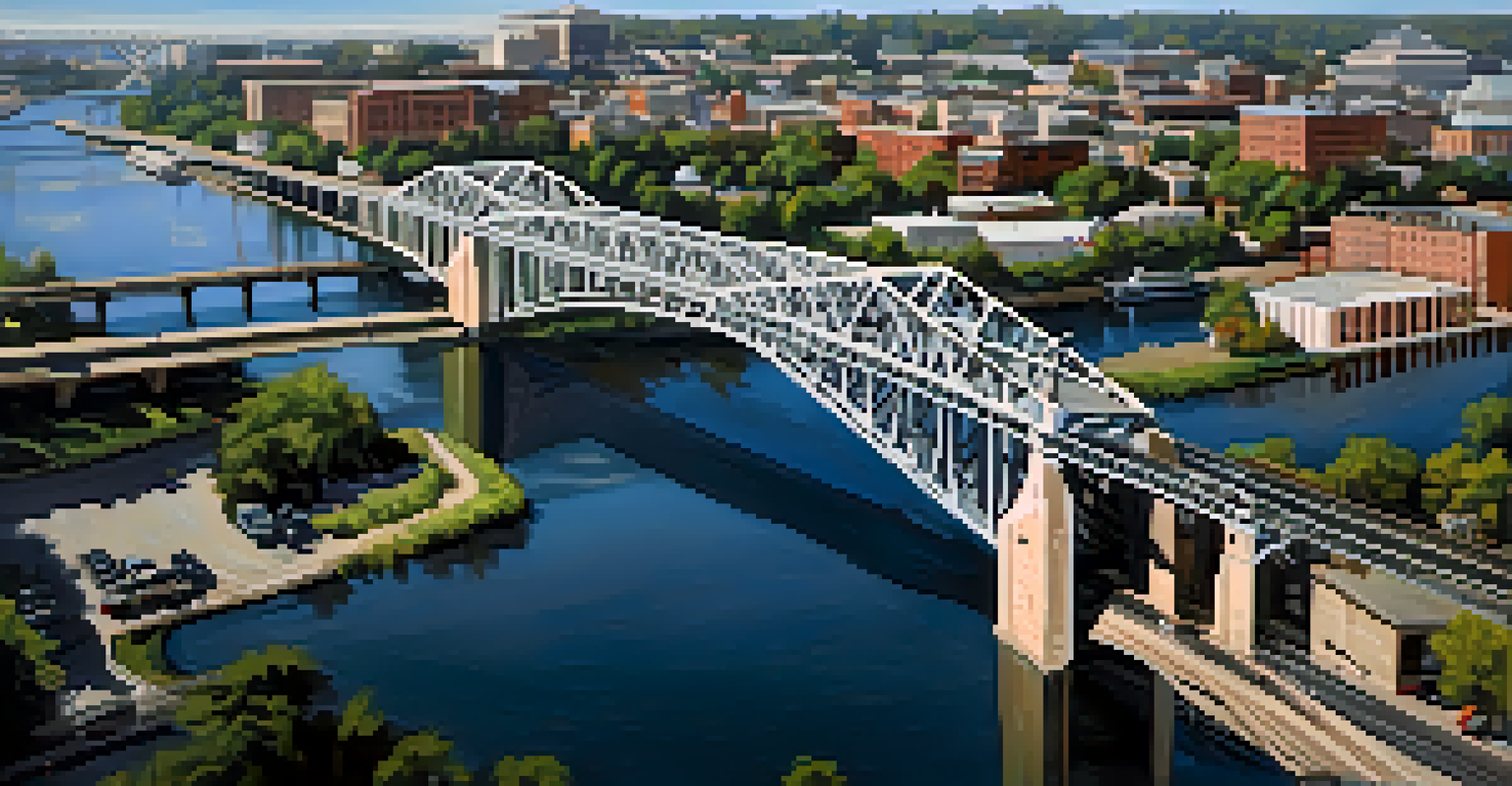Architectural Styles of Sacramento's Historic Bridges Explained

Introduction to Sacramento's Historic Bridges
Sacramento is not just the capital of California; it's also home to a stunning array of historic bridges. These structures serve not only as essential transportation links but also as living pieces of art that reflect the city's history and architectural evolution. From the iconic Tower Bridge to the lesser-known gems, each bridge tells its own story.
Bridges are a symbol of connection, a way to bring people together across barriers and distances.
The bridges of Sacramento represent a blend of various architectural styles, showcasing the influences of different eras and cultures. They are key landmarks that contribute to the city's identity, making them a focal point for both residents and visitors. Understanding these styles provides insight into the city's past and how it has transformed over the years.
In this article, we'll delve into the architectural styles of Sacramento's historic bridges, exploring their unique features and historical significance. So, whether you're a history buff or simply curious about the structures you cross daily, there's something here for everyone.
The Iconic Tower Bridge: A Blend of Art Deco and Functionality
One of Sacramento's most recognizable landmarks, the Tower Bridge, embodies the Art Deco style, characterized by its geometric shapes and bold lines. Completed in 1935, this bridge not only serves as a crucial link across the Sacramento River but also stands as a testament to the aesthetic movement of its time. Its striking gold color and elegant towers make it a favorite spot for photographers and tourists alike.

The bridge features a bascule design, allowing it to lift for passing boats while maintaining a visually appealing structure. This combination of functionality and beauty is a hallmark of Art Deco architecture, which sought to integrate form with function. As you walk across the bridge, you can admire the details that reflect the craftsmanship of the era.
Historic Bridges Reflect Sacramento's Past
Sacramento's historic bridges serve as vital transportation links and showcase the city's architectural evolution.
The Tower Bridge is more than just a crossing; it is a symbol of Sacramento's resilience and growth. It links the downtown area to West Sacramento, making it a vital part of the city’s infrastructure while also serving as a gathering place for community events and celebrations.
The Historic Sacramento River Bridge: A Gothic Revival Gem
The Sacramento River Bridge, often overlooked, is a stunning example of Gothic Revival architecture. This bridge showcases pointed arches and intricate stonework, which are hallmark features of the Gothic style. Completed in 1911, it reflects the architectural trends of the early 20th century, where there was a revival of medieval styles.
Architecture is the art of how to waste space.
Walking across this bridge feels like stepping back in time, with its towering spires and ornate details capturing the imagination. The design not only served a practical purpose but also aimed to inspire awe and reverence for the engineering feats of the time. It stands as a reminder of the historical significance of bridges in connecting communities.
The Gothic Revival style was often associated with cathedrals and grand structures, making the Sacramento River Bridge a unique addition to the city's landscape. Its presence enriches the historical tapestry of Sacramento, reminding us of the artistry involved in its construction and the importance of preserving such landmarks.
The I Street Bridge: A Testament to the Utility of Truss Design
The I Street Bridge is a classic example of a truss bridge, an architectural style that emphasizes strength and functionality. Built in 1911, this bridge's design includes a series of triangular shapes that distribute weight efficiently, allowing it to support heavy loads while minimizing materials used. This practical approach reflects the engineering ingenuity of the era.
Unlike the more decorative styles of other bridges, the I Street Bridge prioritizes utility, showcasing the principles of industrial architecture. Its straightforward design serves as a reminder of the importance of functionality in infrastructure. As you drive or walk across, you can appreciate the simplicity and effectiveness of its construction.
Architectural Diversity in Bridge Design
Each bridge in Sacramento features unique architectural styles, from Art Deco to Gothic Revival, highlighting the city's rich design heritage.
The truss design has become synonymous with reliability, making the I Street Bridge a vital transportation route for the Sacramento community. It connects the bustling downtown area to the neighborhoods beyond, demonstrating how functional design can seamlessly integrate with everyday life.
The J Street Bridge: A Historic Steel Arch Structure
The J Street Bridge stands out with its impressive steel arch design, a feature that combines aesthetic appeal with structural integrity. Completed in 1935, this bridge showcases the elegance of steel construction, which allows for longer spans without the need for numerous supports. Its sweeping arches create an iconic silhouette against the Sacramento skyline.
The use of steel in bridge design became popular during the 20th century, allowing for innovative designs that were previously impossible with traditional materials. The J Street Bridge exemplifies this advancement, as it not only provides essential connectivity but also enhances the beauty of the surrounding landscape. As you admire its sleek lines, you can appreciate the engineering advancements that made it possible.
This bridge has become a beloved feature of Sacramento, frequently appearing in photographs and local art. Its unique design highlights the importance of blending functionality with artistic expression, making it a perfect example of how architecture can elevate everyday structures into something extraordinary.
The 7th Street Bridge: A Rustic Touch with Its Wooden Design
Embracing a more rustic aesthetic, the 7th Street Bridge features a wooden design that sets it apart from its metal counterparts. Built in the late 1800s, this bridge reflects a time when wood was a primary building material, showcasing craftsmanship that emphasizes natural beauty. Its weathered appearance adds character and a sense of history that resonates with those who cross it.
The bridge's wooden structure offers a warm contrast to the sleek lines of modern designs, reminding us of the simpler times when such materials were abundant. As you traverse this bridge, you can feel the connection to the past, where each plank tells a story of the people who used it long before us. This tactile experience enhances our appreciation for the natural world.
Exploring Bridges Enhances Local Culture
Visiting these historic bridges offers a deeper appreciation for Sacramento's history and the community connections they foster.
Despite the challenges of maintaining wooden structures, the 7th Street Bridge remains a beloved part of Sacramento's landscape. It serves as a nostalgic reminder of the city's early development and the role of bridges in facilitating community connections.
The Legacy of Sacramento's Historic Bridges
Sacramento's historic bridges represent more than just functional structures; they are integral to the city's identity and heritage. Each bridge, with its unique architectural style, offers a glimpse into the past, reflecting the evolution of engineering and design. They stand as symbols of the connectivity and community that define Sacramento.
As we explore these architectural marvels, we gain a deeper understanding of the city’s history and the people who shaped it. These bridges have weathered the test of time, serving countless generations and adapting to the changing needs of the community. Their preservation is crucial to maintaining the cultural fabric of Sacramento.

In celebrating these historic bridges, we honor the craftsmanship and creativity of those who built them. Their stories enrich our understanding of the city and inspire us to appreciate the beauty in both form and function. As we move forward, let’s ensure that these architectural treasures continue to connect us for generations to come.
Visiting Sacramento's Historic Bridges: A Journey Through Time
Visiting Sacramento's historic bridges is more than just crossing from one side to another; it's an opportunity to embark on a journey through time. Each bridge offers a unique perspective on the city's history, making them popular spots for both locals and tourists. Whether you're an architecture enthusiast or simply looking for a scenic walk, these bridges will not disappoint.
Many of these bridges are located near parks and waterfront areas, providing a perfect backdrop for leisurely strolls or picnics. As you explore, take the time to read the informational plaques that share fascinating stories about each bridge’s construction and significance. These small details can deepen your appreciation for what you’re experiencing.
So, the next time you find yourself in Sacramento, consider making a day of exploring these architectural wonders. Whether you take photos, enjoy a walk, or simply soak in the views, these historic bridges will leave you with lasting memories and a newfound appreciation for the city’s rich history.